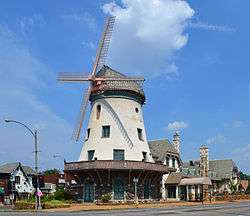Bevo Mill, St. Louis
| Bevo Mill | |
|---|---|
| St. Louis neighborhood | |
|
The Bevo Mill Restaurant, namesake of the neighborhood (located at the intersection of Morganford and Gravois) | |
|
Location of Bevo Mill within St. Louis | |
| Country | United States |
| State | Missouri |
| City | St. Louis |
| Wards | 13, 14 |
| Area | |
| • Total | 1.37 sq mi (3.5 km2) |
| Population (2010)[1] | |
| • Total | 12,654 |
| • Density | 9,200/sq mi (3,600/km2) |
| ZIP code(s) | Part of 63116 |
| Area code(s) | 314 |
| Website | stlouis-mo.gov |
Bevo Mill is a neighborhood located in south St. Louis, Missouri.
Populace
The Bevo Mill area is directly to the west of the neighborhood of Dutchtown that was a center of mass German settlement in St. Louis in the mid-1800s. The area's population was waning in the 1990s, and in Europe there was a war in the early 90s that drove people from their homes. Many people left a dangerous situation in Bosnia and Croatia behind and today much of the Bevo Mill neighborhood is populated with immigrants, particularly Bosnian Americans and Croatian Americans. St. Louis is now home to the largest Bosnian population per capita outside Europe. An estimated 70,000 Bosnians live in the St. Louis metro area[2] The growth of the immigrant population in Saint Louis has helped stem the decline in the city's population.[3] Many Bosnians have revitalized the city of St. Louis through buying homes in South St. Louis and opening up new businesses which has helped to stimulate the economy.[4] Some of the businesses in Bevo Mill are, bakeries, cafés, taverns, nightclubs, restaurants, and neighborhood grocery stores and butcher shops. They have also helped transform the neighbourhood from a crime-ridden area into a decent quarter.[5]
Trouble at the mill
On 20 March 2009, Business Week reported that the Bevo Mill restaurant had shut its doors.[6] The website at the time was marked under construction and on 29 March 2009, the website stated that the account was suspended. It was in mid-2008 that the Anheuser-Busch company had merged with the Belgian-Brazilian based company InBev, forming Anheuser-Busch InBev and possibly diminishing their involvement with some local properties, such as the Bevo Mill restaurant. The restaurant subsequently reopened for Sunday brunch under new management.[7]
Demographics
In 2010 Bevo Mill's racial makeup was 74.2% White, 13.8% Black, 0.4% Native American, 4.6% Asian, 3.9% Two or More Races, and 3.1% Some Other Race. 7.5% of Bevo Mill's population was of Hispanic or Latino origin.[8]
See also
- Holly Hills, St. Louis, southeast of Bevo
- The Hill, St. Louis' Italian neighborhood
- Chinatown, St. Louis, the former downtown Chinese neighborhood
- History of the Bosnians in St. Louis
- St. Louis Islamic Center
References
- ↑ Census Summary By Neighborhoods Archived September 2, 2009, at the Wayback Machine.
- ↑ http://www.theatlanticcities.com/politics/2013/02/why-are-there-so-many-bosnians-st-louis/4668/
- ↑ Preston, Julia (15 April 2010). "Work Force Fueled by Highly Skilled Immigrants". New York Times. Retrieved September 30, 2011.
- ↑ Tucci, Linda (11 April 1999). "Refugees Revitalizing City Neighborhoods". St. Louis Business Journal. Retrieved September 30, 2011.
- ↑ "How Muslim refugees from Bosnia transformed a corner of the Midwest". The Economist. 19 December 2015. Retrieved 22 December 2015.
- ↑ "Bevo Mill closes".
- ↑ "The Bevo Mill" Archived January 10, 2010, at the Wayback Machine., Official Website
- ↑ http://dynamic.stlouis-mo.gov/census/neigh_comp.cfm
Coordinates: 38°34′54″N 90°16′02″W / 38.5816°N 90.2672°W
